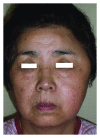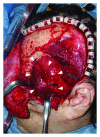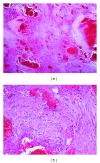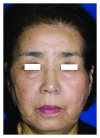Spindle cell hemangioendothelioma of the temporal muscle resected with zygomatic osteotomy: a case report of an unusual intramuscular lesion mimicking sarcoma
- PMID: 22606579
- PMCID: PMC3350060
- DOI: 10.1155/2011/481654
Spindle cell hemangioendothelioma of the temporal muscle resected with zygomatic osteotomy: a case report of an unusual intramuscular lesion mimicking sarcoma
Abstract
Spindle cell hemangioendothelioma (SCH) was originally described by Weiss and Enzinger (1986) as a low-grade angiosarcoma resembling both cavernous hemangioma and Kaposi's sarcoma. Recent studies suggest that SCH is a benign neoplasm or reactive lesion accompanying a congenital or acquired vascular malformation. Most SCHs present as one or more nodules affecting the dermis or subcutis of the distal extremities. Few reports describe SCH of the head and neck region; even fewer note intramuscular SCH. Here, we describe a case of SCH involving the temporal muscle mimicking soft tissue sarcoma, who had a successful surgical treatment with a coronal approach and zygomatic osteotomy.
Figures






Similar articles
-
Spindle cell hemangioma (hemangioendothelioma) of the head and neck: case report of an unusual (or underdiagnosed) tumor.Oral Surg Oral Med Oral Pathol Oral Radiol Endod. 2008 Feb;105(2):216-21. doi: 10.1016/j.tripleo.2007.03.005. Epub 2007 Jul 25. Oral Surg Oral Med Oral Pathol Oral Radiol Endod. 2008. PMID: 17656123
-
Spindle cell hemangioendothelioma. A low-grade angiosarcoma resembling a cavernous hemangioma and Kaposi's sarcoma.Am J Surg Pathol. 1986 Aug;10(8):521-30. Am J Surg Pathol. 1986. PMID: 3740350
-
Immunohistochemical Analysis of Oral Spindle Cell Hemangioma.J Dent (Shiraz). 2025 Jun 1;26(2):194-198. doi: 10.30476/dentjods.2024.101499.2305. eCollection 2025 Jun. J Dent (Shiraz). 2025. PMID: 40510225 Free PMC article.
-
Multiple enchondromas associated with spindle-cell hemangioendotheliomas. An overlooked variant of Maffucci's syndrome.Am J Surg Pathol. 1995 Sep;19(9):1029-38. doi: 10.1097/00000478-199509000-00006. Am J Surg Pathol. 1995. PMID: 7661276 Review.
-
Recently characterized vascular tumours of skin and soft tissues.Histopathology. 1991 Dec;19(6):489-501. doi: 10.1111/j.1365-2559.1991.tb01497.x. Histopathology. 1991. PMID: 1786935 Review.
Cited by
-
Successful Outcome After Intralesional Curettage for Spindle Cell Hemangioma of Fibula in an Infant: A Case Report.Front Pediatr. 2021 Nov 4;9:767927. doi: 10.3389/fped.2021.767927. eCollection 2021. Front Pediatr. 2021. PMID: 34805052 Free PMC article.
-
Spindle Cell Hemangioma of Lower Lip: The Fourth Case Report with Review of Literature.J Maxillofac Oral Surg. 2023 Mar;22(1):141-145. doi: 10.1007/s12663-020-01503-y. Epub 2021 Jan 8. J Maxillofac Oral Surg. 2023. PMID: 36703685 Free PMC article.
-
Spindle Cell Hemangioma in the Mucosa of the Upper Lip: A Case Report and Review of the Literature.Case Rep Dent. 2018 Mar 26;2018:1370701. doi: 10.1155/2018/1370701. eCollection 2018. Case Rep Dent. 2018. PMID: 29780644 Free PMC article.
References
-
- Weiss SW, Enzinger FM. Spindle cell hemangioendothelioma. A low-grade angiosarcoma resembling a cavernous hemangioma and Kaposi’s sarcoma. American Journal of Surgical Pathology. 1986;10(8):521–530. - PubMed
-
- Eltorky M, Chesney TM, Sebes J, Hall JC. Spindle cell hemangioendothelioma: report of three cases and review of the literature. Journal of Dermatologic Surgery and Oncology. 1994;20(3):196–202. - PubMed
-
- Terashi H, Itami S, Kurata S, Sonoda T, Takayasu S, Yokoyama S. Spindle cell hemangioendothelioma: report of three cases. Journal of Dermatology. 1991;18(2):104–111. - PubMed
-
- Tosios KI, Gouveris I, Sklavounou A, Koutlas IG. Spindle cell hemangioma (hemangioendothelioma) of the head and neck: case report of an unusual (or underdiagnosed) tumor. Oral Surgery, Oral Medicine, Oral Pathology, Oral Radiology and Endodontology. 2008;105(2):216–221. - PubMed
-
- Isayama T, Iwasaki H, Ogata K, Naito M. Intramuscular spindle cell hemangioendothelioma. Skeletal Radiology. 1999;28(8):477–480. - PubMed
Publication types
LinkOut - more resources
Full Text Sources
Miscellaneous

